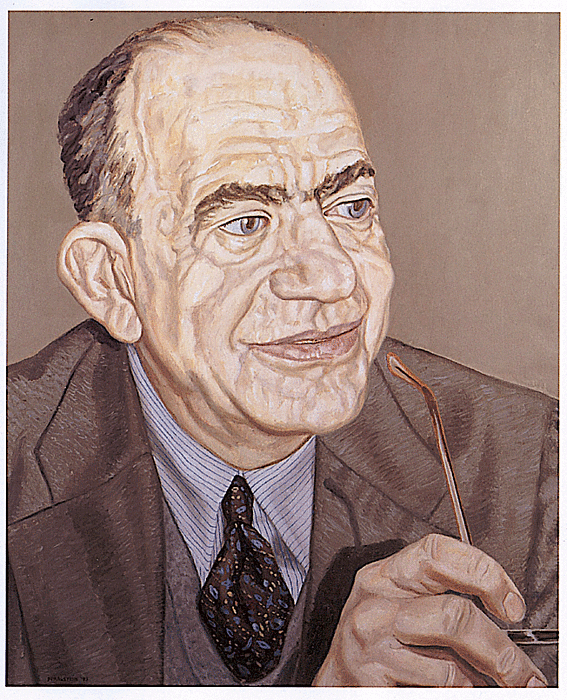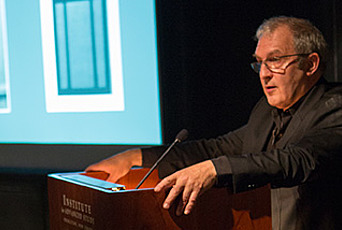Erwin Panofsky–Jan van Eyck–Philip Pearlstein

The splendid portrait of Erwin Panofsky, late Professor in the School of Historical Studies, installed in the Institute’s Historical Studies–Social Science Library, was commissioned from Philip Pearlstein in 1993. The portrait was the result of a series of coincidences that Panofsky liked to call “accidents on the highways of tradition,” this time involving a collision of at least a half dozen vehicles of history.
First, in 1964, one of the Institute’s Trustees, Harold Linder, gave a modest sum for art for our library, in memory of Herbert H. Lehman. Evidently long forgotten, the existence of the fund was very kindly brought to my attention by Elliott Shore, our librarian at the time, but it proved devilishly difficult––the second coincidence––to hit upon an appropriate and really first-rate work for the amount available. The difficulty was in fact fortunate because––the third coincidence––the money was still there when Panofsky’s centennial approached and the idea, which seems inevitable in retrospect, dawned on me that it would be singularly appropriate if we could obtain for the centennial of one of the leading art historians of our time, a portrait by one of the leading artists of our time.
The choice of that artist, Philip Pearlstein, was also inevitable and providential. Pearlstein had already done a double portrait of two leading American art historians, Linda Nochlin and Richard Pommer, and a portrait of Panofsky by him would stand in the noble tradition of Max Liebermann’s portrayal of Wilhelm von Bode, and Oskar Kokoschka’s painting of Hans and Erika Tietze. A fourth coincidence was that Philip and I had known each other for more than forty years, ever since we were graduate students together at the Institute of Fine Arts in New York, where in spring of 1950 we listened, in adjoining seats—and this is the fifth coincidence—to the lectures of none other than Erwin Panofsky, who taught there regularly. I telephoned Philip and made him an offer that, under those circumstances, he could hardly refuse. What came as an astonishing surprise, however, was that instead of producing a modest little sketch or drawing, which is all I expected at the agreed price, Pearlstein made a monumental, over lifesize and laborintensive painting.

Pearlstein’s unusual artistic generosity was matched by an equally unusual scholarly generosity. Besides his own memories of Panofsky, he based the portrait on several snapshots I sent him, some of which were kindly lent by Gerda Panofsky.1 Well-trained art historian that he is, when he finished the picture, Pearlstein sent me the following documentary letter describing his working procedure, along with several slides:
May 1, 1993
Dear Irving, Enclosed is the original slide, my painting and the studio set-up crudely improvised—I suspended a piece of transparent vellum from an old canvas-stretcher frame that is leaning against an unused easel, onto which I projected, from the rear, the original slide which then became my “model.” I tried to paint as if from a still-life. Projecting the slide this way allowed me to keep on the usual studio lights I work with. You can see that I re-positioned the hand holding the eye glasses, to compress the composition, and as I told you, I painted the details of the hand from my own hand as a model—there simply wasn’t enough detail in the photo—and my hand is just as pudgy as Panofsky’s! Thanks for the opportunity to do this.
Yours,
Philip
The artist’s use of the word compress is a dead giveaway, for with this device he transformed the snapshot into a modern, Philip Pearlstein version of those powerfully analytical and evocative portraits by Early Netherlandish painters like Jan van Eyck. In fact, with its intensely “upfront” view, body and arms hidden below the frame, leaving visible only the hand with fingers holding a personal symbol (eyeglasses for the scholar), the portrait of Panofsky is reminiscent of the Man with a Pink in Berlin.
The next-to-last coincidence is that the lectures we heard in New York were none other than the manuscript of what soon became one of Panofsky’s most important books, Early Netherlandish Painting, Its Origins and Character (Harvard University Press, 1953), and the Man with a Pink was one of the well-known works he discussed.

while using a projected snapshot as a model.
The final coincidence is that Pearlstein actually bears an uncanny personal resemblance to Panofsky, both physically (not only the pudgy hands) and in his personal warmth and good humor. Hence Pearlstein’s portrait of Panofsky may also be viewed as an appropriately whimsical indulgence in that fateful tendency of artists described in the Renaissance by the famous aphorism “every painter paints himself” (ogni dipintore dipinge se), which Leonardo considered the painter’s “worst defect.”2
1. I have been informed by Panofsky’s son, Wolfgang, that the snapshot was taken by the latter’s son, Edward, then aged fifteen, in Kennebunkport, Maine, in July 1962.
2. M. Kemp, “‘Ogni dipintore dipinge se:’ A Neoplatonic Echo in Leonardo’s Art Theory?,” in C. H. Clough, ed., Cultural Aspects of the Italian Renaissance: Essays in Honour of Paul Oskar Kristeller (Manchester, 1976), 311–33; F. Zollner, “‘Ogni pittore dipinge sè.’ Leonardo da Vinci and ‘Automimesis,’” in M. Winner, ed., Der Künstler über sich in seinem Werk. Internationales Symposium der Bibliotheca Hertziana. Rom 1989 (Weinheim, 1992), 137–60.


